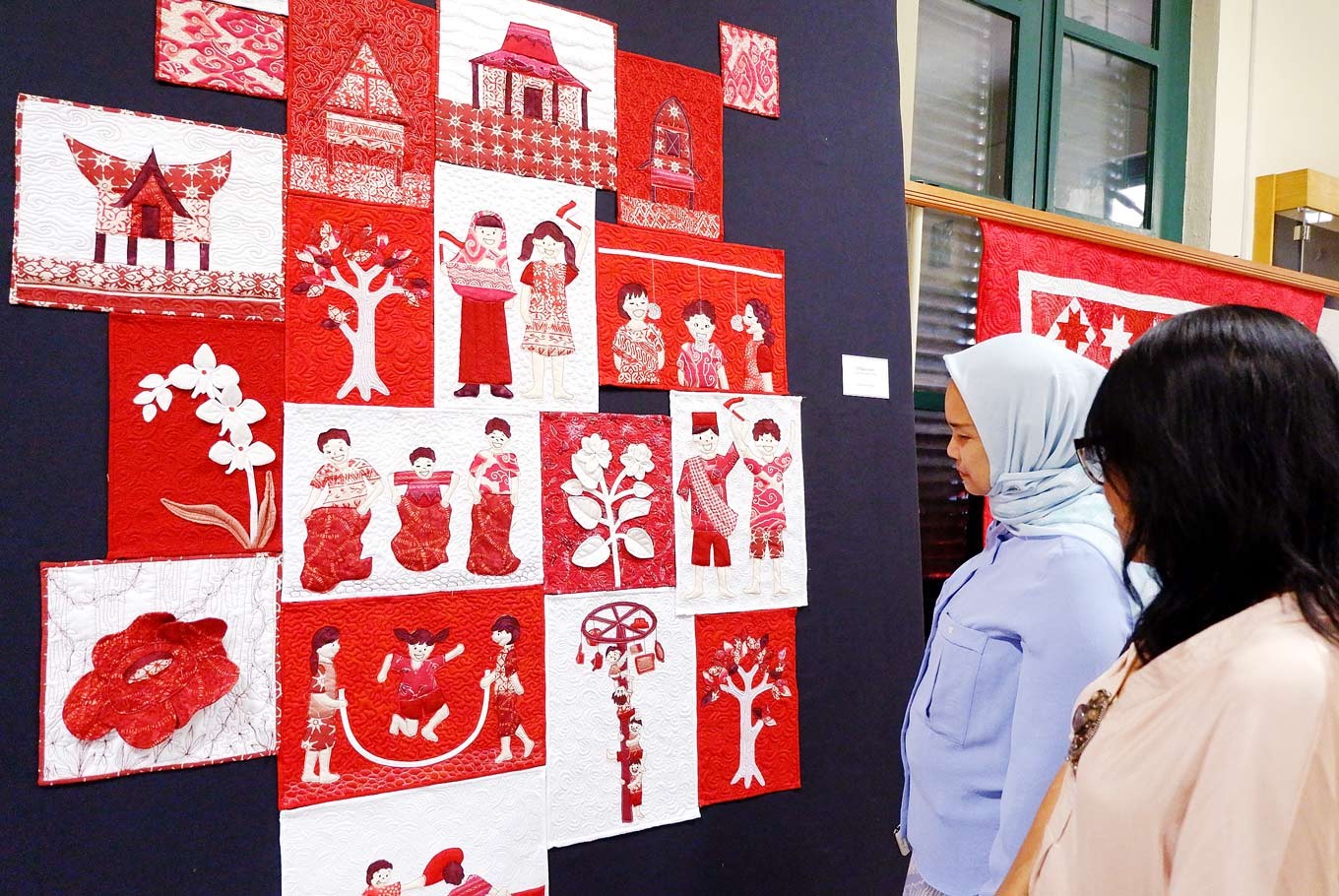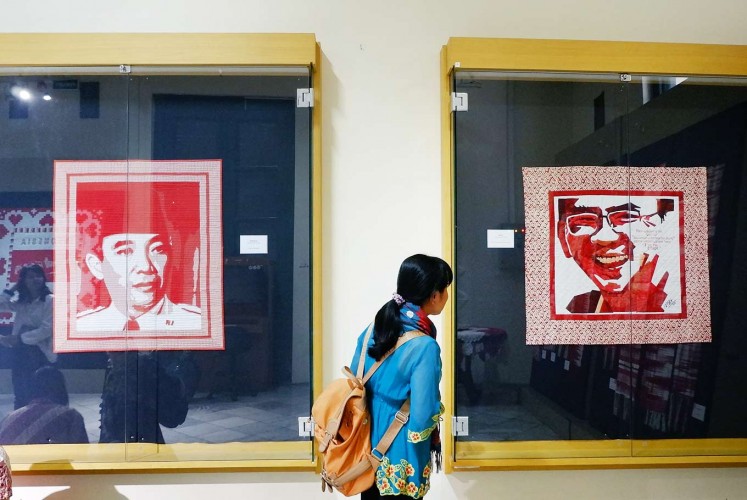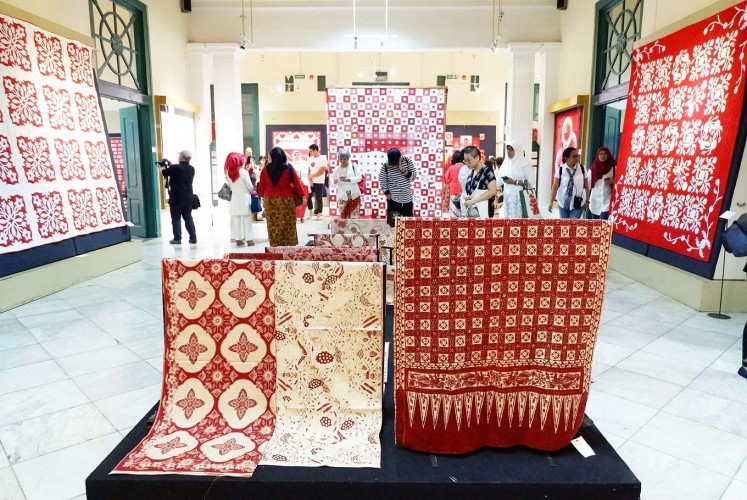Popular Reads
Top Results
Can't find what you're looking for?
View all search resultsPopular Reads
Top Results
Can't find what you're looking for?
View all search resultsCelebrating Indonesia through textiles
A textile exhibition celebrates Indonesia and its diversity.
Change text size
Gift Premium Articles
to Anyone
A
s people raise the country’s flag to mark Independence Day on Aug. 17, the Meraki artisan group is celebrating the special occasion the way they know best — by using threads and needles to pay tribute to freedom fighters.
The group came up with the idea to hold a textile exhibition at a museum in Jakarta in March with its members showcasing varied works using shades of red and white, the colors of the country’s national flag.
“Red and white unite us. Unity in diversity,” said Meraki member Lita Jonathans, who also leads the research and development division of Wastra Indonesia, an organization founded in January 2016 that preserves Indonesian fabrics.
The organization, along with the Jakarta Tourism and Cultural Agency, opened the “Merah Putih” (Red and White) exhibition, which runs until Aug. 26, at the Textile Museum in Jakarta.
Over 100 artisans, ranging from weavers and batik makers to quilters, are displaying over 210 red-and-white handcrafted woven fabrics, batik and patchwork quilts from around the country.
Echoing the principle of “Bhinneka Tunggal Ika” (Unity in Diversity), the quilts stole visitors’ attention during the exhibition’s opening day on Saturday mostly because they were beautifully crafted and depict public figures, such as Indonesia’s first president Sukarno and former Jakarta governor Basuki “Ahok” Tjahaja Purnama.
Up close: A visitor looks at quilts depicting Indonesia’s first president Sukarno (left) and former Jakarta governor Basuki Tjahaja Purnama. (JP/A. Kurniawan Ulung)One quilt depicts traditional Independence Day events, such as the cracker-eating race, the pacu karung (sack race) and the panjat pinang (slippery pole climbing) game.
Quilter Wien Wardana, who helped organize the exhibition, said each quilter depicted in their works their own interpretation of how they defined Independence Day and what they did to promote unity in diversity.
Wien chose the popular lone star pattern and surrounded it with fruits and leaves, which she said symbolized prosperity.
Quilter Wiwik Winarni named her work “Mariner’s Compass” to pay tribute to ancestors who were sailors in Indonesia, the world’s largest archipelagic country.
Wiwik, who owns the Melati Patchwork studio in Bekasi, West Java, said that for “Mariner’s Compass”, she used a traditional paper-piecing technique to create designs that were directly stitched onto a paper pattern that served as the foundation.
Meraki artisan group, along with the Jakarta Tourism and Cultural Agency, opened the “Merah Putih” (Red and White) exhibition, which runs until Aug. 26, at the Textile Museum in Jakarta. (JP/A. Kurniawan Ulung)“I learned this technique from a certified instructor in Melbourne, Australia, in October last year,” said Wiwik, who has practiced the art of quilting since 1999.
Vintage quilts are also being displayed at the Textile Museum, such as a double wedding ring quilt by Sri Halimah, who made it for her daughter as a wedding present.
Another participant, Lita, who lives in Jakarta, is showcasing woven fabrics with freestyle motifs, which is different from fabrics from East Nusa Tenggara (NTT), where weaving is a tradition and woven fabrics are used as both an item of clothing and a dowry.
Due to a lack of weaving teachers in Jakarta, she said she felt compelled to learn basic weaving skills by reading books and browsing YouTube.
Fascinated: Actress Christine Hakim (left) and her friends attend the Merah Putih exhibition. (JP/A. Kurniawan Ulung)“In Jakarta, weaving is something new. We started doing it in the last two to three years,” said Lita, who teaches weaving to nearly 30 housewives at her house.
During the exhibition, Wastra Indonesia also holds discussions, including one on Aug. 15 on Jambi batik. On Aug. 16, Hiyashinta Klise, the founder of Lamerenan Tenun Tanimbar, is scheduled to give a talk about her efforts to empower women weavers on the Tanimbar Islands in Maluku and about preserving heritage there.
The organization also holds various workshops, such as one on kinchaku, a traditional Japanese drawstring bag worn like a purse or handbag, on Aug. 22, and one on shibori, a Japanese manual resist dyeing technique that produces patterns on fabric, on Aug. 26.
To thank the Textile Museum during Indonesia’s 72nd Independence Day, Wastra Indonesia gave them a quilt made by 72 quilters from numerous cities, including Pekanbaru in Riau, Medan in North Sumatra, Wonosobo in Central Java and Malang in East Java. “Each quilter created a small piece of quilt at home and we combined 72 small quilts into this one big quilt,” Wien said.
A textile exhibition by Meraki artisan group celebrates Indonesia and its diversity. (JP/A. Kurniawan Ulung)














